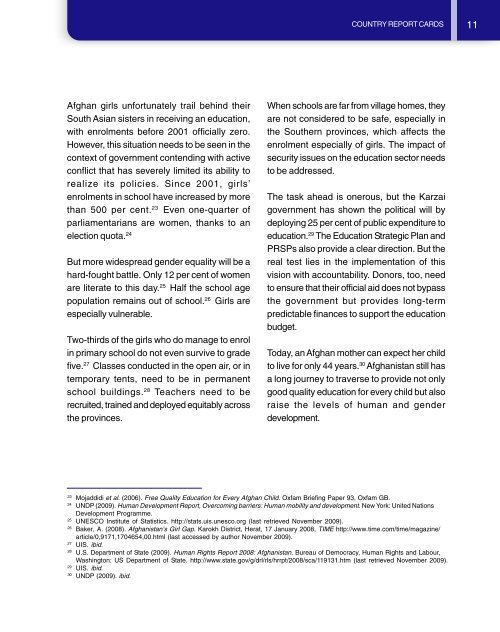Cover(final) - United Nations Girls' Education Initiative
Cover(final) - United Nations Girls' Education Initiative
Cover(final) - United Nations Girls' Education Initiative
Create successful ePaper yourself
Turn your PDF publications into a flip-book with our unique Google optimized e-Paper software.
COUNTRY REPORT CARDS 11<br />
Afghan girls unfortunately trail behind their<br />
South Asian sisters in receiving an education,<br />
with enrolments before 2001 officially zero.<br />
However, this situation needs to be seen in the<br />
context of government contending with active<br />
conflict that has severely limited its ability to<br />
realize its policies. Since 2001, girls’<br />
enrolments in school have increased by more<br />
than 500 per cent. 23 Even one-quarter of<br />
parliamentarians are women, thanks to an<br />
election quota. 24<br />
But more widespread gender equality will be a<br />
hard-fought battle. Only 12 per cent of women<br />
are literate to this day. 25 Half the school age<br />
population remains out of school. 26 Girls are<br />
especially vulnerable.<br />
Two-thirds of the girls who do manage to enrol<br />
in primary school do not even survive to grade<br />
five. 27 Classes conducted in the open air, or in<br />
temporary tents, need to be in permanent<br />
school buildings. 28 Teachers need to be<br />
recruited, trained and deployed equitably across<br />
the provinces.<br />
When schools are far from village homes, they<br />
are not considered to be safe, especially in<br />
the Southern provinces, which affects the<br />
enrolment especially of girls. The impact of<br />
security issues on the education sector needs<br />
to be addressed.<br />
The task ahead is onerous, but the Karzai<br />
government has shown the political will by<br />
deploying 25 per cent of public expenditure to<br />
education. 29 The <strong>Education</strong> Strategic Plan and<br />
PRSPs also provide a clear direction. But the<br />
real test lies in the implementation of this<br />
vision with accountability. Donors, too, need<br />
to ensure that their official aid does not bypass<br />
the government but provides long-term<br />
predictable finances to support the education<br />
budget.<br />
Today, an Afghan mother can expect her child<br />
to live for only 44 years. 30 Afghanistan still has<br />
a long journey to traverse to provide not only<br />
good quality education for every child but also<br />
raise the levels of human and gender<br />
development.<br />
23<br />
Mojaddidi et al. (2006). Free Quality <strong>Education</strong> for Every Afghan Child. Oxfam Briefing Paper 93, Oxfam GB.<br />
24<br />
UNDP (2009). Human Development Report, Overcoming barriers: Human mobility and development. New York: <strong>United</strong> <strong>Nations</strong><br />
Development Programme.<br />
25<br />
UNESCO Institute of Statistics. http://stats.uis.unesco.org (last retrieved November 2009).<br />
26<br />
Baker, A. (2008). Afghanistan’s Girl Gap. Karokh District, Herat, 17 January 2008, TIME http://www.time.com/time/magazine/<br />
article/0,9171,1704654,00.html (last accessed by author November 2009).<br />
27<br />
UIS. ibid.<br />
28<br />
U.S. Department of State (2009). Human Rights Report 2008: Afghanistan. Bureau of Democracy, Human Rights and Labour,<br />
Washington: US Department of State. http://www.state.gov/g/drl/rls/hrrpt/2008/sca/119131.htm (last retrieved November 2009).<br />
29<br />
UIS. ibid.<br />
30<br />
UNDP (2009). ibid.

















